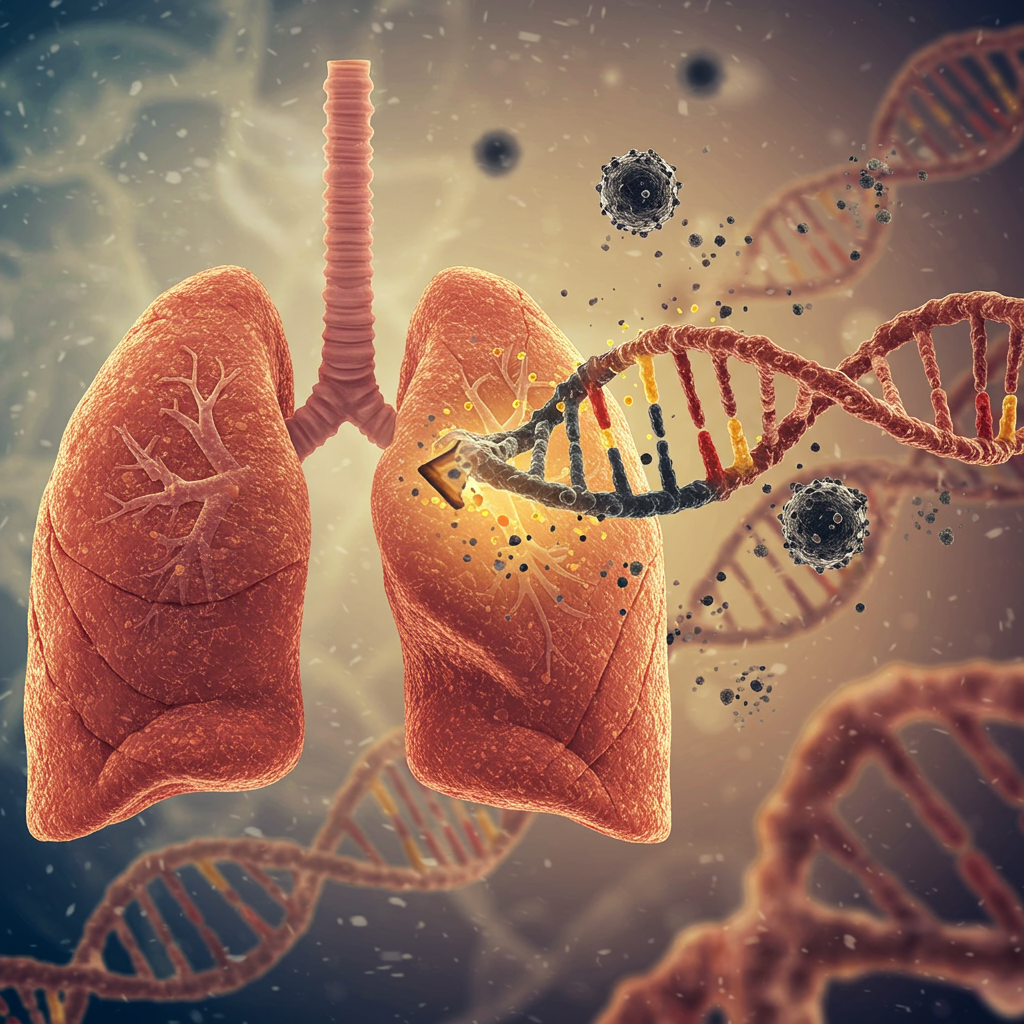Startling new research from the National Institutes of Health (NIH) reveals a direct link between air pollution and the development of lung cancer in people who have never smoked. Scientists discovered that tiny airborne particles cause specific genetic mutations in lung tumors, providing compelling evidence that polluted air isn’t just a risk factor, but a direct mutagen capable of altering DNA and initiating cancer growth. This groundbreaking study sheds light on the causes of lung cancer in the significant portion of patients who have no history of tobacco use, offering crucial insights for prevention and future treatment strategies.
Unraveling Lung Cancer’s Mysteries in Non-Smokers
Lung cancer remains the deadliest form of cancer globally. While smoking is its most well-known cause, a substantial number of cases—between 10% and 25% worldwide—occur in individuals who have never smoked. For years, understanding the exact origins of these non-smoker lung cancers has been a key challenge for researchers. Known risks include secondhand smoke, radon gas, asbestos, and air pollution, but the precise biological mechanisms initiating cancer in this population remained less clear compared to smoking-related cases. Dr. Maria Teresa Landi, a senior author of the new study and principal investigator of the Sherlock-Lung project at NIH’s National Cancer Institute (NCI), stated the research aimed to better define these causes to inform prevention and therapy.
Genomic Evidence Pinpoints Air Pollution’s Role
Published in the prestigious journal Nature, this large-scale study represents the most extensive whole-genome analysis of lung cancer in never-smokers to date. Researchers from the NCI and the University of California San Diego analyzed lung tumor samples from 871 never-smoking patients. These participants were located across 28 diverse geographic regions on four continents, primarily Europe, North America, and Asia, focusing on individuals of European and East Asian descent. By sequencing the entire genomes of these tumors, scientists could identify distinct patterns of DNA damage and mutations—molecular fingerprints reflecting past exposures.
The findings were striking. The tumors of patients living in areas with high levels of fine particulate air pollution (PM2.5), often stemming from traffic and industry, displayed significantly more genetic mutations compared to those from regions with cleaner air. This wasn’t just a general increase; the tumors from polluted areas showed a greater diversity of mutations. They even exhibited mutational patterns previously associated with tobacco smoking, suggesting air pollution can induce similar types of DNA damage.
More Than Just a Statistic: How Pollution Alters DNA
This study goes beyond simply linking pollution to cancer risk at a population level, as epidemiological studies do. It drills down to the cellular and genetic level. Dr. George Thurston, a renowned expert on air pollution’s health impacts at New York University (not involved in the study), described this type of genomic research as critical “environmental detective work.” He explained that tools like whole-genome sequencing help scientists understand exactly how pollution affects health at a fundamental biological level, complementing broader population-based findings.
The researchers identified specific genetic targets impacted by air pollution. They found associations between pollution exposure and detrimental changes in the TP53 gene. TP53 is a vital tumor suppressor gene, and mutations here are common in many cancers. Additionally, the study linked air pollution to the premature shortening of telomeres. Telomeres are protective caps on the ends of chromosomes; they naturally shorten with age, but accelerated shortening due to pollution exposure can impair a cell’s normal function and increase cancer risk. A clear dose-response relationship was observed, meaning higher pollution exposure correlated with a greater number of mutations and shorter telomeres.
Comparing Air Pollution and Secondhand Smoke
A notable comparison within the study involved secondhand tobacco smoke. While tumors from patients exposed to secondhand smoke showed a slight increase in mutations and shorter telomeres compared to those with no known exposure, they did not exhibit an increase in the specific cancer-driving mutations or distinct mutational signatures found in the air pollution group. The study authors suggested that the mutagenic power of fine particulate air pollution, in terms of causing cancer-driving genetic changes, might be stronger than that of secondhand smoke. They also noted that the reliability of self-reported secondhand smoke exposure data could influence this comparison. Dr. Thurston highlighted that regardless of the relative mutagenicity shown in this specific genomic analysis, air pollution from fossil fuels is far more ubiquitous and difficult to avoid than secondhand smoke for most people.
Geographic Clues and New Signatures
The global nature of the study revealed interesting geographic patterns. A specific gene mutation strongly linked to exposure to aristolochic acid was found almost exclusively in study subjects from Taiwan. Aristolochic acid is a plant substance used in some traditional medicines. While previously linked to bladder, liver, and kidney cancers via ingestion, this study provides compelling new evidence linking it to lung cancer, potentially through inhalation of traditional herbal remedies. Researchers see this finding as a significant public health alert, particularly in regions where these remedies are used.
Intriguingly, the study also identified a previously unknown mutational signature present in the majority of never-smoker lung cancers analyzed. This signature was absent in smokers’ tumors and did not correlate with air pollution or other known environmental factors. This discovery points to at least one additional, unidentified cause of lung cancer in non-smokers, opening up a new avenue for future investigation. Prior research (including a 2021 NCI study) had already begun classifying never-smoker lung cancers into molecular subtypes based on mutation levels (“Piano,” “Mezzo-forte,” “Forte”), suggesting they aren’t a single disease. This new signature adds further complexity.
Air Pollution: A Crisis Fueled by Policy?
This study arrives amidst growing concerns about the health toll of air pollution. Climate change exacerbates the problem through increased wildfires, droughts, and extreme heat events that impact air quality. Recent reports indicate nearly half the U.S. population lives with dangerous pollution levels. Air pollution was already considered the second leading cause of lung cancer globally, and this research reinforces that link with direct genomic evidence.
The article reporting this study also placed it within a challenging policy context. It noted concerns about federal funding cuts impacting research on climate change’s health effects and pollution’s disproportionate impact on vulnerable communities. Furthermore, it highlighted political actions, such as a recent U.S. Senate vote mentioned in the original article, which advocates warned could worsen the problem. By potentially reducing incentives to cut emissions and subsidizing fossil fuels, while simultaneously cutting healthcare access, such policies could lead to increased pollution, more illness, higher healthcare costs, and preventable deaths, according to health advocates like Moms Clean Air Force.
Looking Ahead: Prevention and Broader Research
The findings from this NIH study are a critical step towards understanding and preventing lung cancer in never-smokers. By identifying air pollution and potentially other specific environmental exposures like aristolochic acid as direct causes of DNA damage, researchers can focus on more targeted prevention strategies.
The Sherlock-Lung study is ongoing. Future phases aim to expand research to include participants from more diverse ethnic backgrounds and geographic regions, such as Latin America, Africa, and Australia. Researchers also plan to investigate other potential environmental exposures that could contribute to lung cancer in never-smokers, including factors like marijuana smoke, e-cigarettes, radon, and asbestos, alongside collecting more detailed local pollution data. This continued research is vital for building a comprehensive picture of lung cancer’s diverse origins in this growing patient population.
Frequently Asked Questions
What specifically did the NIH study find about air pollution and lung cancer in non-smokers?
The study found that fine particulate air pollution (PM2.5) is directly linked to an increase in cancer-causing genetic mutations in the lung tumors of people who have never smoked. It showed that tumors from patients in highly polluted areas had more mutations and specific types of DNA damage, including alterations to the TP53 gene and premature shortening of telomeres, providing genomic proof that air pollution is a mutagen capable of initiating lung cancer.
How does air pollution cause lung cancer mutations compared to smoking?
Both air pollution and smoking cause DNA damage. This study found that fine particulate air pollution is strongly associated with an increase in cancer-driving genetic mutations and specific mutational signatures in never-smokers. While secondhand smoke was linked to some increased mutations and shorter telomeres, it did not show the same increase in cancer-driving mutations. This suggests air pollution may have a powerful, direct mutagenic effect initiating cancer at the DNA level, comparable in some ways to primary smoking effects, although the exact biological pathways differ.
What does this study mean for lung cancer prevention in non-smokers?
This research provides strong evidence that improving air quality is a direct strategy for preventing lung cancer in non-smokers. By identifying environmental factors like air pollution as causes of specific DNA mutations, it validates public health efforts to reduce emissions. It also highlights the potential for geographic-specific prevention strategies, like addressing the use of substances containing aristolochic acid in certain regions. Understanding these causes allows for more targeted interventions beyond tobacco cessation.




